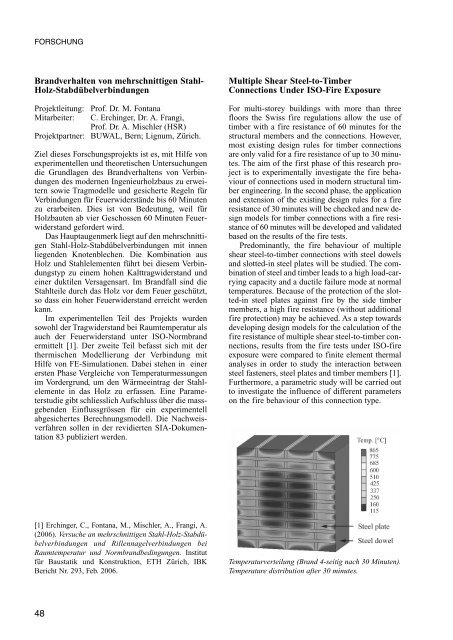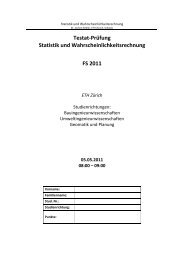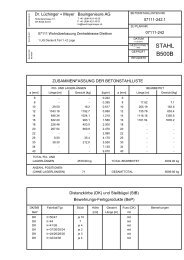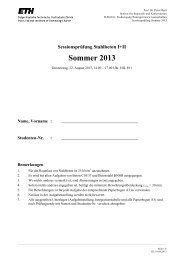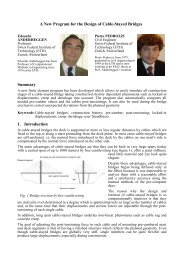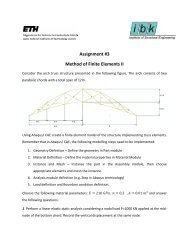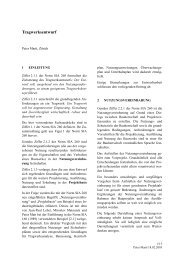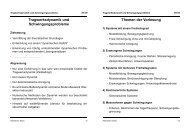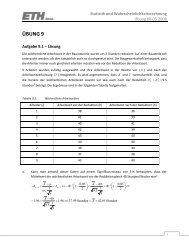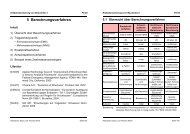IBK Jahresbericht 2004-2006 - Institut für Baustatik und Konstruktion ...
IBK Jahresbericht 2004-2006 - Institut für Baustatik und Konstruktion ...
IBK Jahresbericht 2004-2006 - Institut für Baustatik und Konstruktion ...
Sie wollen auch ein ePaper? Erhöhen Sie die Reichweite Ihrer Titel.
YUMPU macht aus Druck-PDFs automatisch weboptimierte ePaper, die Google liebt.
FORSCHUNG<br />
Brandverhalten von mehrschnittigen Stahl-<br />
Holz-Stabdübelverbindungen<br />
Projektleitung: Prof. Dr. M. Fontana<br />
Mitarbeiter: C. Erchinger, Dr. A. Frangi,<br />
Prof. Dr. A. Mischler (HSR)<br />
Projektpartner: BUWAL, Bern; Lignum, Zürich.<br />
Ziel dieses Forschungsprojekts ist es, mit Hilfe von<br />
experimentellen <strong>und</strong> theoretischen Untersuchungen<br />
die Gr<strong>und</strong>lagen des Brandverhaltens von Verbindungen<br />
des modernen Ingenieurholzbaus zu erweitern<br />
sowie Tragmodelle <strong>und</strong> gesicherte Regeln <strong>für</strong><br />
Verbindungen <strong>für</strong> Feuerwiderstände bis 60 Minuten<br />
zu erarbeiten. Dies ist von Bedeutung, weil <strong>für</strong><br />
Holzbauten ab vier Geschossen 60 Minuten Feuerwiderstand<br />
gefordert wird.<br />
Das Hauptaugenmerk liegt auf den mehrschnittigen<br />
Stahl-Holz-Stabdübelverbindungen mit innen<br />
liegenden Knotenblechen. Die Kombination aus<br />
Holz <strong>und</strong> Stahlelementen führt bei diesem Verbindungstyp<br />
zu einem hohen Kalttragwiderstand <strong>und</strong><br />
einer duktilen Versagensart. Im Brandfall sind die<br />
Stahlteile durch das Holz vor dem Feuer geschützt,<br />
so dass ein hoher Feuerwiderstand erreicht werden<br />
kann.<br />
Im experimentellen Teil des Projekts wurden<br />
sowohl der Tragwiderstand bei Raumtemperatur als<br />
auch der Feuerwiderstand unter ISO-Normbrand<br />
ermittelt [1]. Der zweite Teil befasst sich mit der<br />
thermischen Modellierung der Verbindung mit<br />
Hilfe von FE-Simulationen. Dabei stehen in einer<br />
ersten Phase Vergleiche von Temperaturmessungen<br />
im Vordergr<strong>und</strong>, um den Wärmeeintrag der Stahlelemente<br />
in das Holz zu erfassen. Eine Parameterstudie<br />
gibt schliesslich Aufschluss über die massgebenden<br />
Einflussgrössen <strong>für</strong> ein experimentell<br />
abgesichertes Berechnungsmodell. Die Nachweisverfahren<br />
sollen in der revidierten SIA-Dokumentation<br />
83 publiziert werden.<br />
Multiple Shear Steel-to-Timber<br />
Connections Under ISO-Fire Exposure<br />
For multi-storey buildings with more than three<br />
floors the Swiss fire regulations allow the use of<br />
timber with a fire resistance of 60 minutes for the<br />
structural members and the connections. However,<br />
most existing design rules for timber connections<br />
are only valid for a fire resistance of up to 30 minutes.<br />
The aim of the first phase of this research project<br />
is to experimentally investigate the fire behaviour<br />
of connections used in modern structural timber<br />
engineering. In the second phase, the application<br />
and extension of the existing design rules for a fire<br />
resistance of 30 minutes will be checked and new design<br />
models for timber connections with a fire resistance<br />
of 60 minutes will be developed and validated<br />
based on the results of the fire tests.<br />
Predominantly, the fire behaviour of multiple<br />
shear steel-to-timber connections with steel dowels<br />
and slotted-in steel plates will be studied. The combination<br />
of steel and timber leads to a high load-carrying<br />
capacity and a ductile failure mode at normal<br />
temperatures. Because of the protection of the slotted-in<br />
steel plates against fire by the side timber<br />
members, a high fire resistance (without additional<br />
fire protection) may be achieved. As a step towards<br />
developing design models for the calculation of the<br />
fire resistance of multiple shear steel-to-timber connections,<br />
results from the fire tests <strong>und</strong>er ISO-fire<br />
exposure were compared to finite element thermal<br />
analyses in order to study the interaction between<br />
steel fasteners, steel plates and timber members [1].<br />
Furthermore, a parametric study will be carried out<br />
to investigate the influence of different parameters<br />
on the fire behaviour of this connection type.<br />
[1] Erchinger, C., Fontana, M., Mischler, A., Frangi, A.<br />
(<strong>2006</strong>). Versuche an mehrschnittigen Stahl-Holz-Stabdübelverbindungen<br />
<strong>und</strong> Rillennagelverbindungen bei<br />
Raumtemperatur <strong>und</strong> Normbrandbedingungen. <strong>Institut</strong><br />
<strong>für</strong> <strong>Baustatik</strong> <strong>und</strong> <strong>Konstruktion</strong>, ETH Zürich, <strong>IBK</strong><br />
Bericht Nr. 293, Feb. <strong>2006</strong>.<br />
Temperaturverteilung (Brand 4-seitig nach 30 Minuten).<br />
Temperature distribution after 30 minutes.<br />
48


